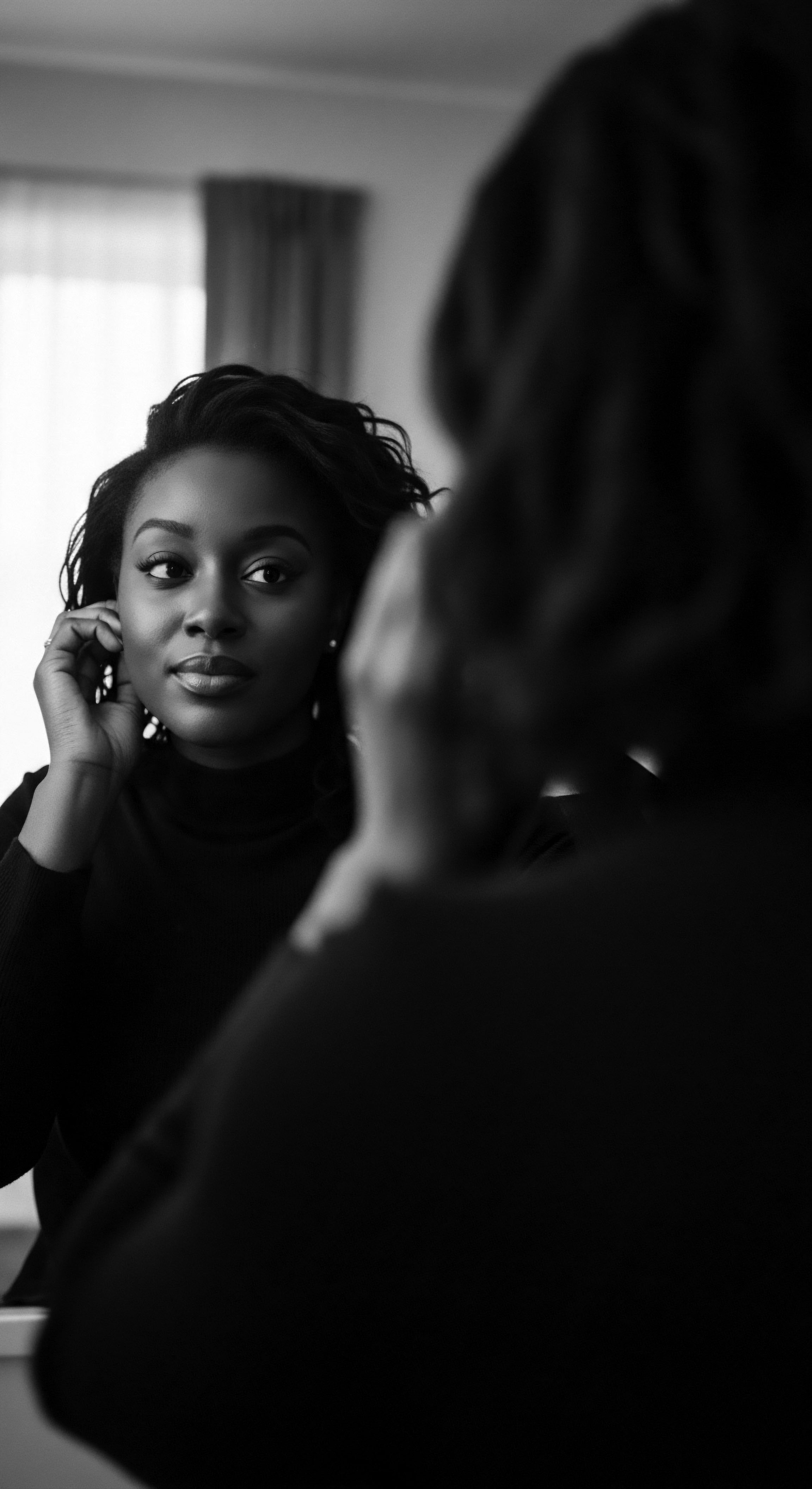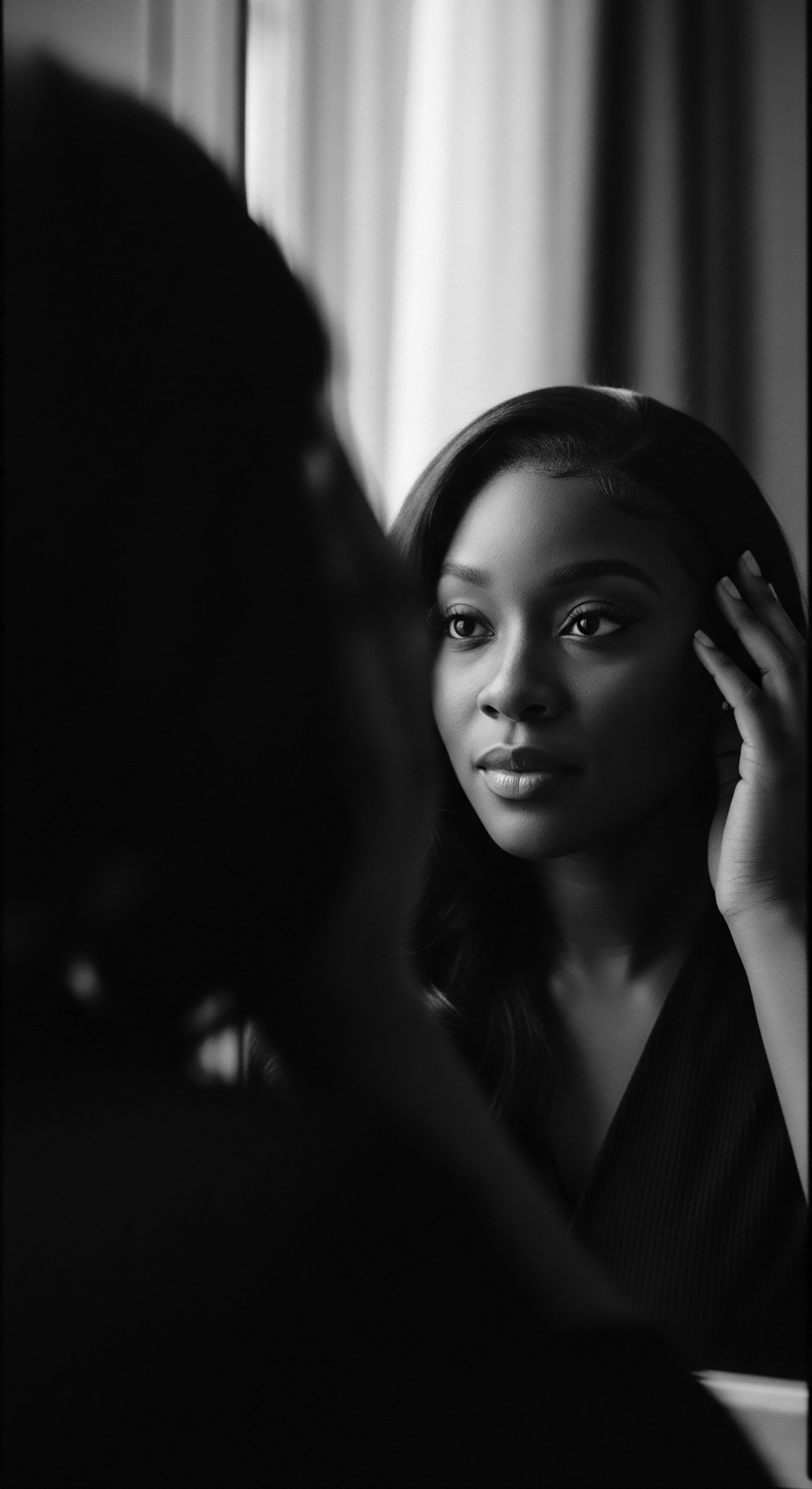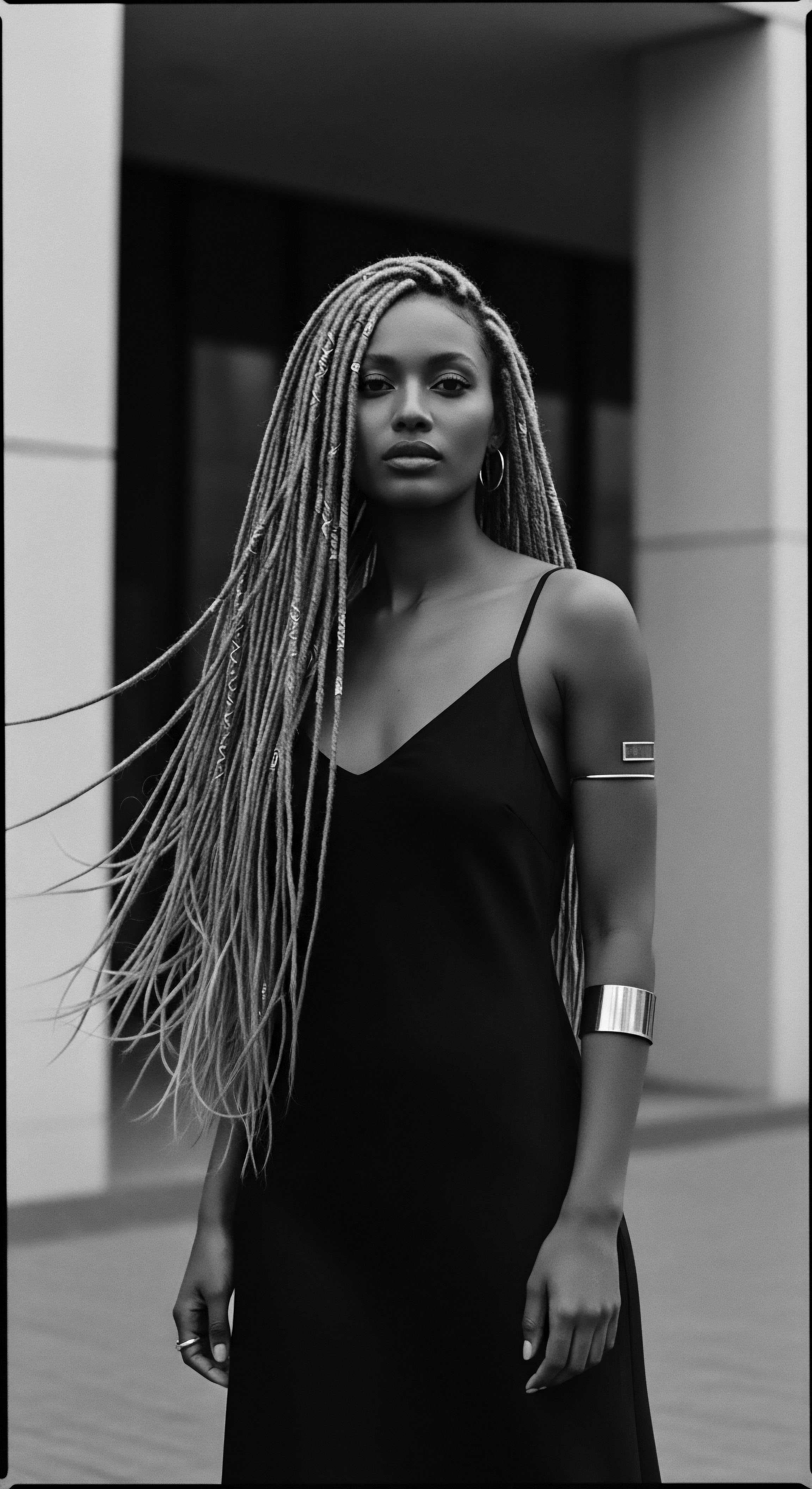
Roots
Consider for a moment the hair that graces your crown, particularly if its texture coils, crimps, or curls in glorious formations. For countless generations, across continents and through trials, textured hair has served as a silent chronicle, a living testament to ancestry, resilience, and wisdom. Its very nature, often perceived as a challenge in drier climates, holds a deep story.
To truly comprehend why strands with such remarkable character often yearn for moisture, we must look beyond surface appearances. We begin not with lament, but with reverence for the elemental building blocks that grant this hair its unique, enduring identity.
The predisposition of textured hair to dryness is not a flaw in its design; it reflects specific architectural realities at the microscopic level, shaped by millennia. The journey of each hair strand begins beneath the scalp, in the hair follicle. Unlike the largely circular follicles that produce straight hair, those yielding coily and curly strands exhibit an elliptical, or flattened, cross-section. Imagine a ribbon, spiraling as it grows, rather than a smooth, straight cord.
This distinct, curved pathway of the follicle dictates the subsequent shape of the emerging hair, compelling it to coil and bend from its very inception. This anatomical difference profoundly influences how moisture interacts with the hair.

Hair Anatomy and Its Ancestral Echoes
The individual hair fiber, a marvel of protein arrangement, comprises three primary layers ❉ the medulla, the cortex, and the cuticle. The outermost layer, the cuticle, is a shield composed of overlapping, scale-like cells. In straight hair, these scales lie relatively flat, forming a smooth, protective surface.
However, on textured hair, particularly those with tighter coils, these cuticle scales naturally tend to lift or remain slightly open along the curves and twists of the strand. This inherent characteristic creates minute openings, akin to tiny windows that are perpetually ajar, allowing moisture to escape more readily into the surrounding atmosphere.
The unique elliptical structure and lifted cuticles of textured hair inherently invite moisture loss, a characteristic rather than a deficiency.
Consider the natural oils, known as sebum, produced by the scalp’s sebaceous glands. This sebum serves as the scalp’s own moisturizer and conditioner, migrating down the hair shaft to coat and protect it. On straight hair, sebum experiences a relatively unimpeded journey from root to tip. With the spiraling form of textured hair, however, this natural oil distribution becomes a far more arduous task.
The tight bends and turns of the coils act as impediments, hindering the smooth flow of sebum, leaving the mid-lengths and ends of the hair often thirsty for lubrication. Studies suggest that in some instances, the sebaceous glands themselves might be less densely packed in the scalp of individuals with textured hair, contributing to a reduced overall sebum output. This biological reality necessitates a deliberate approach to external hydration, a fact understood by ancestral communities long before scientific terms articulated it.

Tracing the Hydration Imperative
This biological inclination towards dryness has shaped historical hair care practices across African and diasporic cultures. Generations past intuitively understood the hair’s constant thirst. Their solutions, rooted in observation and communal wisdom, frequently involved deep conditioning methods and the sealing properties of natural ingredients.
The understanding that the hair’s external layer needed fortification to hold water was not a scientific discovery but a lived truth passed down. The very survival of these hair traditions, adapting to environments often far removed from their origins, speaks volumes about the early recognition of these intrinsic qualities.
The term “porosity” finds its echo in these historical practices. Textured hair often exhibits higher porosity, meaning its cuticle layers, already prone to lifting, readily absorb water. While this might sound advantageous for hydration, it presents a counter-intuitive challenge ❉ the same open structure that welcomes moisture allows it to depart just as swiftly.
Ancient rituals for hair care, therefore, revolved around not just introducing moisture, but critically, sealing it within the hair shaft using rich butters and oils. This knowledge, born of daily experience, mirrors modern scientific advice on managing hair porosity.
- Elliptical Form ❉ The cross-sectional shape of the hair strand, influencing its coil pattern.
- Cuticle Integrity ❉ The outermost protective layer, prone to lifting along curves.
- Sebum Flow ❉ Natural scalp oils struggle to descend the coiling hair shaft.

Ritual
The distinctive biology of textured hair, with its elliptical form and propensity for dryness, has profoundly shaped the rituals and practices that have graced Black and mixed-race communities for centuries. These traditions are not merely cosmetic choices; they embody a profound, communal response to the hair’s inherent needs, a testament to inherited ingenuity. Each plait, twist, or oil application carried a dual purpose ❉ adornment and preservation.

Traditional Styling as Moisture Preservation
Consider the practice of protective styling, a cornerstone of textured hair care across the diaspora. Styles like braids, cornrows, and twists, which carefully tuck away the delicate ends of the hair, directly address the hair’s vulnerability to moisture loss and mechanical stress. The tighter the coil, the more prone the hair is to tangles and knots, which can readily lead to breakage when dry.
By braiding or twisting hair, friction against clothing and environmental elements is reduced, and the natural oils present are kept closer to the strands. This understanding was not gleaned from laboratory experiments; it was a wisdom cultivated through observation, passed down through the gentle, knowing hands of mothers, aunties, and elders.
An anthropological examination of hair in African societies before the transatlantic slave trade reveals hair as a profound marker of identity, status, and spiritual connection. Hairstyles could communicate marital status, age, social rank, or even serve as maps for escape routes during times of enslavement. The intricate designs were also deeply practical, designed to manage the hair’s unique texture and reduce the exposure that contributed to dryness.
For instance, the Yoruba people of Nigeria, as early as the 15th century, practiced “Irun Kiko,” or hair threading, where fibers or threads were wrapped around sections of hair. This method not only created stylized looks but also stretched the hair, making it less prone to tangling, and likely aided in retaining moisture by compacting the cuticle layers.

Historical Lubricants for Dry Hair
The strategic use of emollients and sealants is another ancient solution to the hair’s biological disposition toward dryness. Natural butters and oils were not simply for shine; they formed a vital protective barrier. Shea butter, sourced from the Karite tree, for instance, has been used across West Africa for centuries, not just for skin, but as a rich sealant for hair.
Its dense composition helped trap the precious moisture within the hair shaft, compensating for the natural difficulty of sebum distribution. Similarly, coconut oil, avocado oil, and even animal fats were employed to coat and protect strands from the harsh conditions of daily life, whether under the hot sun or during arduous labor.
Traditional styling methods and ancestral ingredients stand as living solutions to the intrinsic moisture challenges of textured hair.
This historical approach directly corresponds to the scientific observation that textured hair, due to its lifted cuticle, requires external lipid application to supplement its natural protective barrier. The wisdom of these ancestors foresaw the need for “sealing oils” – those that coat the hair to minimize trans-epidermal water loss, a term modern science defines as the evaporation of water from the scalp and hair. The effectiveness of these traditional substances underscores a timeless understanding of haircare that transcended formal scientific inquiry.
| Traditional Practice Protective Hairstyles (braids, twists) |
| Contemporary Scientific Link Reduces mechanical damage and environmental exposure; aids in moisture retention by minimizing surface area contact. |
| Traditional Practice Application of Natural Butters/Oils (shea, coconut) |
| Contemporary Scientific Link Supplements natural sebum distribution, seals cuticle layers, and reduces transepidermal water loss. |
| Traditional Practice Head Coverings (scarves, wraps) |
| Contemporary Scientific Link Physical barrier against elements, helps maintain internal humidity around hair, preventing dehydration. |
| Traditional Practice These heritage practices represent profound, early adaptations to the biological needs of textured hair. |
The cultural significance of bonnets and headscarves, beyond their aesthetic or ceremonial roles, is deeply rooted in this need for hair preservation. These coverings acted as a physical shield, minimizing exposure to dry air, dust, and friction that could further lift the cuticle and accelerate moisture loss. The nightly ritual of wrapping one’s hair was not merely a step in a routine; it was an act of preserving a vital part of one’s identity, safeguarding the hair’s precious moisture, and honoring a legacy of care.

Relay
The dialogue between the intrinsic biological qualities of textured hair and the practices designed to address its dryness continues into our present day. This conversation is not a new one, but a relay of wisdom across generations, fortified by evolving scientific understanding. The hair’s unique architecture – its elliptical cross-section, the non-uniformity of its keratin bundling, and the behavior of its cuticle – creates specific demands for hydration and care. Modern science now provides granular detail to the observations made by those who came before us, solidifying the importance of holistic regimens.

Why Do Textured Strands Crave Moisture?
One aspect of textured hair’s biology that intensifies its thirst is its inherent fragility. The numerous bends and curves along a coiling strand represent points of stress. When dry, these sections are significantly weaker and more susceptible to fracture during routine manipulation. A study indicated that coily hair can require 5 to 50 times the combing force of straight hair, increasing the likelihood of damage and further compromising the cuticle barrier.
This susceptibility to mechanical stress, exacerbated by dryness, sets up a cycle where damage leads to greater moisture loss, which in turn leads to more breakage. This cycle necessitates constant, gentle attention.
The concept of “Trans-Epidermal Water Loss,” or TEWL, traditionally applied to skin, holds significance for understanding scalp health and its relationship to hair dryness. The scalp of individuals with textured hair is sometimes prone to increased TEWL, implying that water evaporates from the scalp’s surface more quickly. This increased evaporation can contribute to overall scalp dryness, which then impacts the hair growing from it.
A healthy, moisturized scalp provides a better environment for hair growth and contributes to the hair’s overall hydration. Ancient remedies often included scalp massages with oils, a practice that not only stimulated blood flow but also provided direct moisture and a protective lipid layer to the scalp, implicitly addressing TEWL before the term existed.

Ancestral Ingredients and Modern Science
The enduring use of specific natural ingredients within Black and mixed-race hair heritage provides a compelling connection between ancestral wisdom and contemporary trichology. Many traditionally used butters and oils, like shea butter, coconut oil, and various plant-based oils, are rich in fatty acids, ceramides, and other lipids. These compounds are precisely what modern hair science identifies as crucial for reinforcing the hair’s lipid barrier, smoothing the cuticle, and thus reducing moisture evaporation.
- Shea Butter ❉ A fatty acid-rich sealant, excellent for retaining moisture and smoothing the cuticle.
- Coconut Oil ❉ Known for its capacity to penetrate the hair shaft, reducing protein loss and providing deep moisture.
- African Black Soap ❉ A traditional cleanser, often formulated with plant ash and shea butter, used for gentle yet effective cleansing.
- Chebe Powder ❉ An ingredient used by Chadian women, traditionally mixed with water and moisturizers to aid length retention by filling hair shaft spaces and sealing the cuticle.
The efficacy of these ingredients, passed down through generations, is increasingly validated by modern research. The understanding that “heavy butters and oils” are beneficial for hair with high porosity, for instance, aligns perfectly with the ancestral practice of using dense, nutrient-dense ingredients. The deep conditioning practices of earlier eras, often involving heated oils or long-duration applications, optimized the penetration and sealing properties of these natural compounds.
The biological architecture of textured hair necessitates a dedicated approach to hydration, a truth understood across generations and now validated by scientific inquiry.

Holistic Care as a Legacy
The holistic philosophy central to Roothea’s perspective finds its roots in ancestral wellness philosophies that saw hair as an extension of one’s overall wellbeing. Dry hair, in this view, was not an isolated problem but a signal that the body, spirit, or environment needed nurturing. This approach extended beyond external applications, considering diet, hydration, and even emotional states as contributors to hair health.
The consistent care rituals were acts of self-reverence and community connection, reinforcing cultural bonds through shared beauty practices. This cultural emphasis on comprehensive wellbeing provides a profound framework for addressing dryness, moving beyond purely cosmetic concerns to a deeper reverence for the self.

Reflection
The journey to comprehend the intrinsic biological qualities that predispose textured hair to dryness reveals more than scientific truths; it unveils a vibrant chronicle of human adaptation, communal wisdom, and enduring beauty. From the curved follicular pathways that shape each coil to the inherent challenge of sebum migration along a spiraling strand, the very biology of textured hair invites a mindful approach to hydration. This understanding, once gleaned through generations of lived experience and ancestral observation, now finds articulation in the language of modern science, yet its spirit remains unchanged.
The story of textured hair and its thirst is not a tale of deficit, but one of magnificent design that requires a particular kind of attunement. It is a story told in the memory of traditions – the strategic plaiting that offered protection from the elements, the nourishing touch of shea butter passed from hand to hand, the quiet nightly ritual of wrapping hair in silk. These practices, born of necessity and knowledge, were direct responses to the hair’s biological call for moisture, a call heard and answered through centuries.
The “Soul of a Strand” echoes through time, reminding us that care for textured hair transcends routine; it is an act of acknowledging a deep, living heritage. Each drop of water, each application of a traditional oil, is a continuation of an unbroken lineage of wisdom. In honoring the unique needs of textured hair, we do more than simply hydrate; we connect with the resilience of a people, and contribute to a legacy of beauty that thrives, not despite its qualities, but because of them. Our ongoing commitment to understanding and tending to this hair preserves a vital part of cultural identity, ensuring its story of strength and beauty continues to unfold for generations.

References
- Society for Pediatric Dermatology. Curly/coily hair care.
- Hexis Lab. Genomic Variation in Textured Hair ❉ Implications for Holistic Hair Care.
- Hella Curls. The Ultimate Guide to Coily Hair ❉ Embracing Your Natural Texture. 2025.
- Spencer Clinic. Textured Hair Loss.
- Sisley Paris. How to take care of wavy, curly and coily hair.
- All Shook Up Hair. Maintaining Coily Hair Between Cuts ❉ Pro Tips. 2025.
- Mukhaye. Why Understanding Your Cuticle Layer Can Help You Achieve Your Hair Goals. 2024.
- Kerastase. The Scientific Truth Behind Curly Hair.
- Croda Beauty. Advancing the future of textured hair solutions. 2025.
- Ducray. Dandruff and coily or curly hair.
- Dr. Serkan Aygin. The Ultimate Guide to High Porosity Hair ❉ Moisture Solutions. 2025.
- University of Salford Students’ Union. The Remarkable History Behind Black Hairstyles. 2024.
- Historical Perspectives on Hair Care and Common Styling Practices in Black Women. 2025.
- Volume 75 No 5 – Sustainability Special Issue – Open Access. 2017.
- Additive Innovation Hub. Curly Hair Layers.
- Sellox Blog. Ancient African Hair Growth Secrets For Healthy Hair. 2021.
- Africa Imports. Traditional African Secrets For Long And Healthy Hair.
- HC Natural Hair. Is your cuticle layer closed???. 2020.
- ResearchGate. Mechanical Properties. (a) Example stress-strain graph for a curly or.
- Clinikally. What is Transepidermal Water Loss and How Does it Affect Your Skin?. 2023.
- Vemel. TRANSEPIDERMAL WATER LOSS – WHAT IT IS AND HOW TO STOP IT.
- ResearchGate. Cross-sectional area of fibres as a function of treatment and hair condition (means +.
- CUNY Academic Works. Examining the Experiences of Black Women with Natural Hair. 2014.
